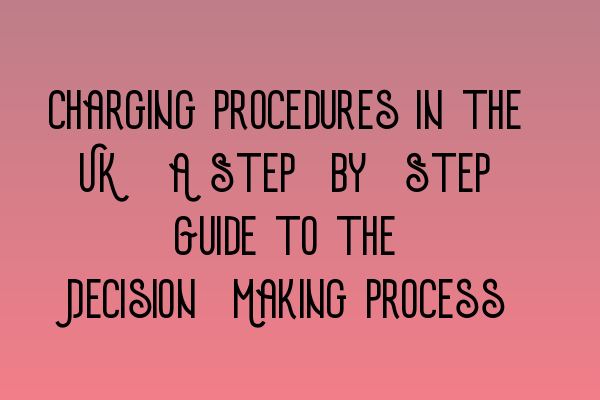Charging Procedures in the UK: A Step-by-Step Guide to the Decision-Making Process
Welcome to SQE Criminal Law & Practice Law UK! As solicitors specializing in criminal law, we understand the significance of charging procedures in the UK and the intricacies involved in the decision-making process. In this blog post, we will provide you with a comprehensive step-by-step guide to help you navigate through the charging procedures effectively.
Step 1: Initial Investigation
Charging procedures usually commence with the initial investigation by law enforcement agencies. This involves collecting evidence, conducting interviews, and analyzing the available information to determine if a crime has been committed. If there is sufficient evidence to support a criminal charge, the authorities proceed to the next step.
Step 2: Decision to Charge
The decision to charge is made by the prosecuting authority, such as the Crown Prosecution Service (CPS). The CPS carefully reviews the evidence gathered during the initial investigation to ascertain whether there is a realistic prospect of conviction. The charging decision takes into account the public interest, the strength of the evidence, and the availability of witnesses.
It is important to note that the decision to charge must be fair, impartial, and comply with legal requirements. If you have questions regarding the charging decision made in your case, our expert team at SQE Criminal Law & Practice Law UK can provide you with the necessary guidance and assistance.
Step 3: Charging Document Preparation
Once the decision to charge has been made, a charging document is prepared. The charging document outlines the specific criminal offenses a person is accused of and forms the basis for the court proceedings. It must be drafted accurately and in compliance with legal requirements to ensure a legitimate case against the accused.
Step 4: Court Appearance
After the charging document has been prepared, the accused is required to appear in court. The court will review the charges and determine the appropriate course of action. This may involve setting a trial date, granting bail, or remanding the accused into custody. It is crucial to engage the services of a skilled criminal law solicitor during this stage to protect your rights and present a strong defense.
If you are preparing for your SQE exams and seeking additional resources, we recommend checking out our related articles:
- SQE 1 Practice Exam Questions
- SQE 1 Practice Mocks FLK1 FLK2
- SQE 2 Preparation Courses
- SQE 1 Preparation Courses
- SRA SQE Exam Dates
These articles provide valuable resources and information to aid in your SQE exam preparation.
Step 5: Trial
If the case proceeds to trial, it is presented before a judge and jury (if applicable). The prosecution and defense present their arguments, examine witnesses, and submit evidence to support their respective positions. The ultimate outcome of the trial depends on the strength of the evidence, the arguments presented, and the decision-making of the judge or jury.
Step 6: Verdict and Sentencing
Once the trial concludes, the judge or jury delivers a verdict. If the accused is found guilty, the court proceeds to sentencing. Sentencing takes into account various factors, such as the seriousness of the offense, the defendant’s criminal history, and any mitigating or aggravating circumstances. The convicted individual may face imprisonment, fines, community service, or other penalties, depending on the nature of the crime committed.
We hope this step-by-step guide has provided you with a clearer understanding of the charging procedures in the UK. If you have any further questions or require legal assistance, please do not hesitate to contact our professional team at SQE Criminal Law & Practice Law UK. We are here to help!
